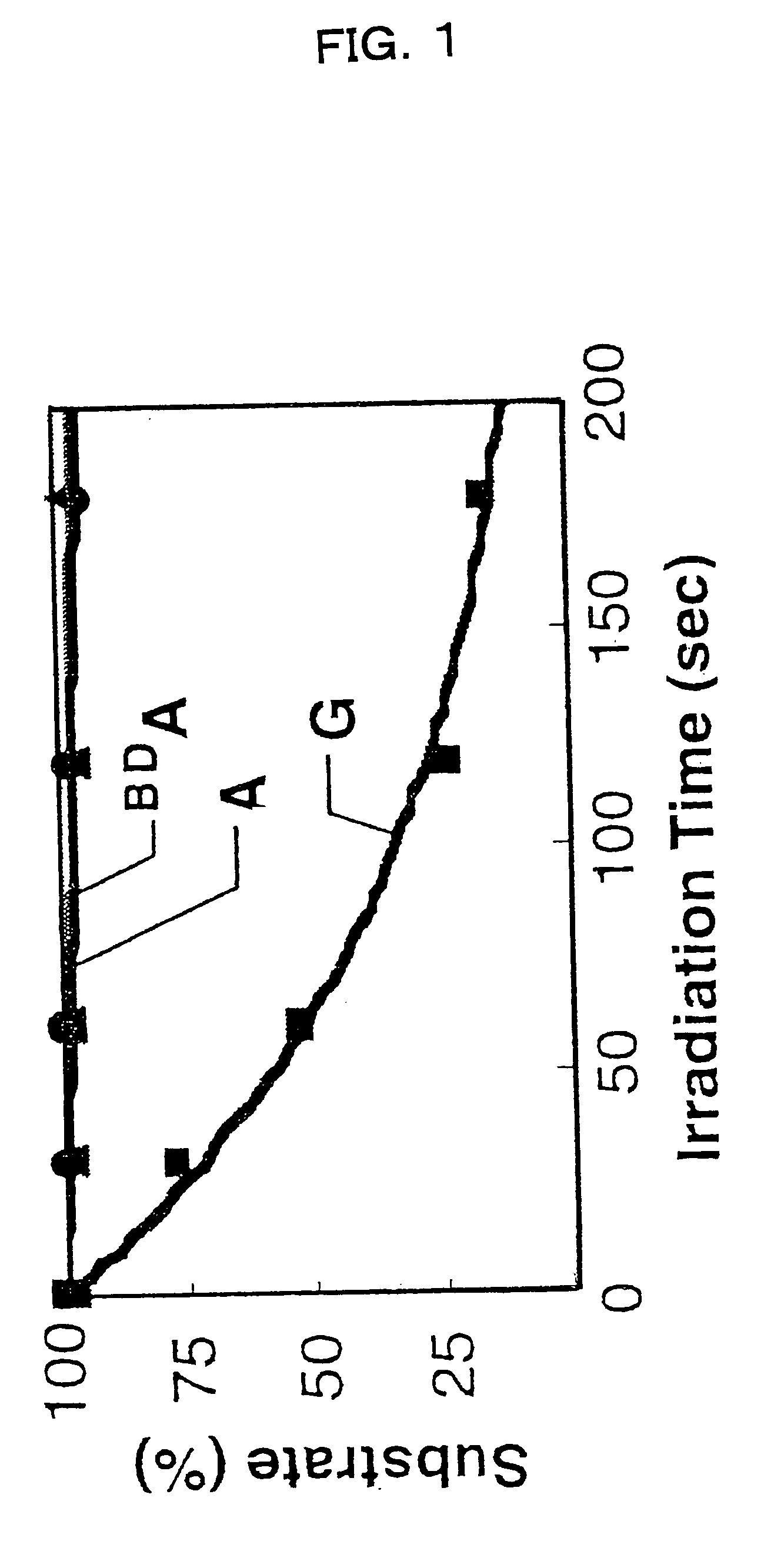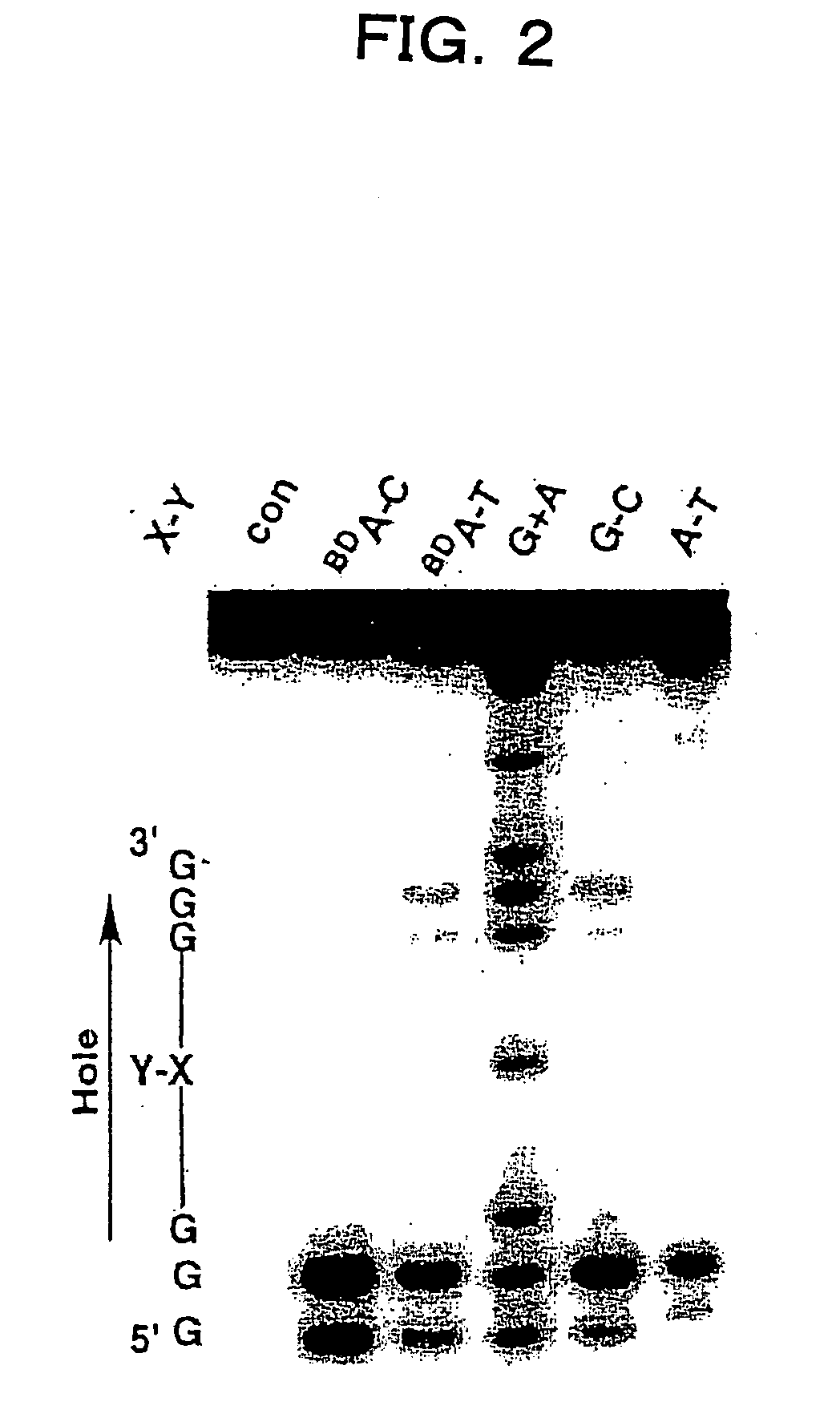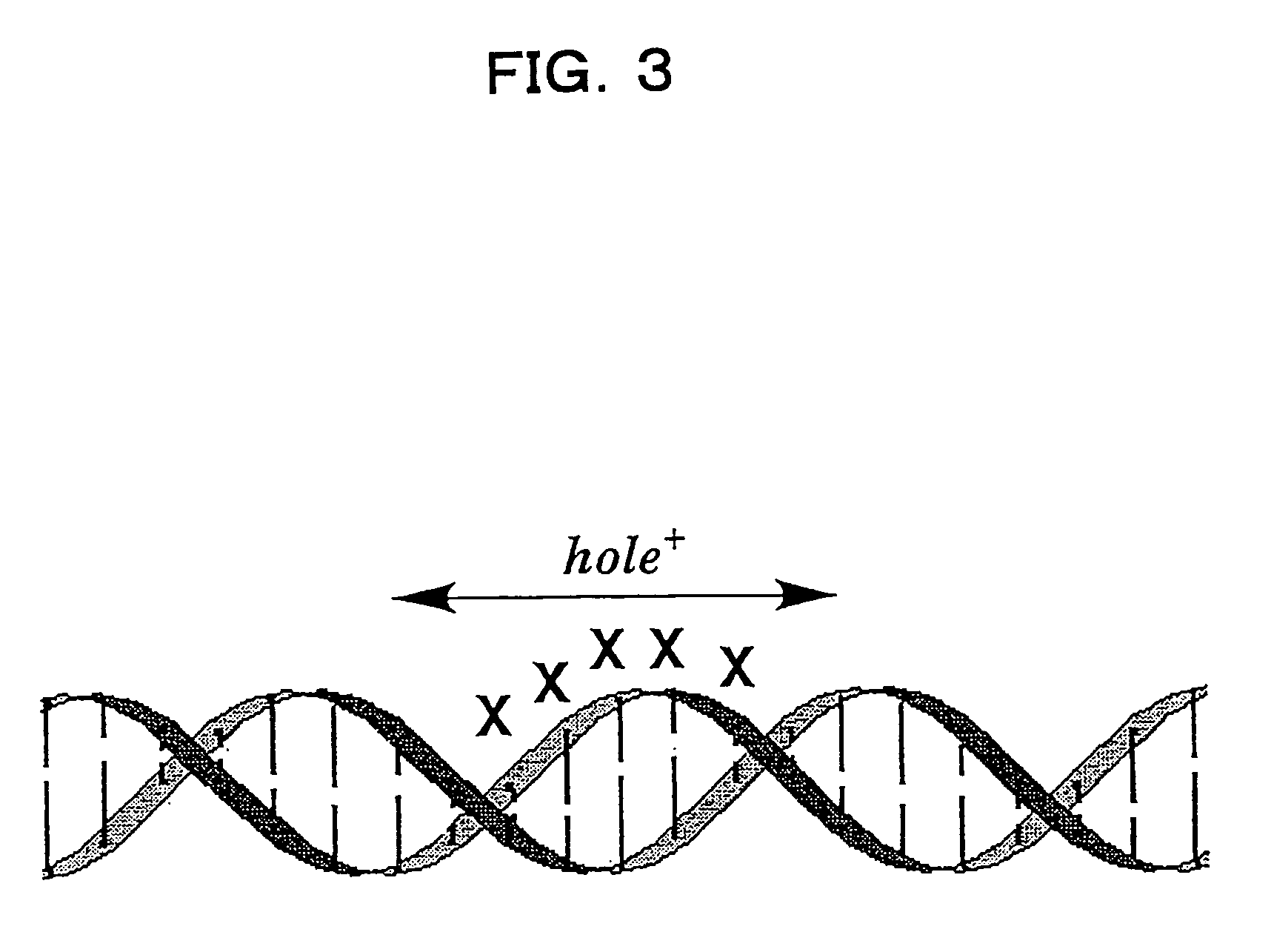Benzodeazaadenine derivative base and electronic material containing the same
a technology of applied in the field of benzodeazaadenine derivative bases and electronic materials containing the same, to achieve the effect of effective hole transport in the dna
- Summary
- Abstract
- Description
- Claims
- Application Information
AI Technical Summary
Benefits of technology
Problems solved by technology
Method used
Image
Examples
example 1
Production of 4-chloro-9-(2′-deoxy-β-D-erythro-pentofuranosyl)-9H-pyrimido[4,5-b]indole (Compound 3)
[0034]4-chloro-1H-pyrimido[4,5-b]indole (1) (360 mg, 1.77 mmol) was suspended in dry acetonitrile (250 mL) at room temperature. To the suspension was added sodium hydride (60% in oil; 142 mg, 3.54 mmol), and the mixture was refluxed under stirring for 10 minutes. Then, ribose (2) (687 mg, 1.77 mmol) was added thereto and stirred at room temperature for 1 hour. The reaction mixture was concentrated and purified by a column chromatography (silica gel, a hexane solution containing 20% ethyl acetate) to obtain the compound (3) (890 mg, 91% yield).
[0035]1H NMR (CDCl3) δ; 38.71 (s, 1H), 8.36 (d, 1H, J=7.9 Hz), 7.99 (d, 2H, J=8.2 Hz), 7.95 (d, 2H, J=6.6 Hz), 7.79 (d, 1H, J=8.4 Hz), 7.37 (dt, 1H, J=8.1, 0.7 Hz), 7.28 (d, 2H, J=8.1 Hz), 7.27 (dt, 1H, J=8.2, 1.1 Hz), 7.23 (d, 2H, J=8.4 Hz), 7.03 (dd, 1H, J=8.8, 6.2 Hz), 5.93 (dt, 1H, J=6.2, 2.7 Hz), 4.86 (dd, 2H, J=11.1, 3.5 Hz), 4.59 (dd, 1H, ...
example 2
Production of 4-amino-9-(2′-deoxy-β-D-erythro-pentofuranosyl)-9H-pyrimido[4,5-b]indole (Compound 4)
[0039]The compound 3 obtained in Example 1 (300 mg, 0.54 mmol) was suspended in 20 mL of methanolic ammonia (saturated at −76° C.), and stirred at 150° C. for 10 hours in a closed vessel. Then, the solution in the vessel was concentrated and purified by a column chromatography (silica gel, a chloroform solution containing 5% methanol) to obtain the compound (4) (117 mg, 72% yield).
[0040]1H NMR (DMSO-d6) δ; 38.31 (d, 1H, J=7.7 Hz), 8.27 (s, 1H), 7.84(d, 1H, J=8.2 Hz), 7.37 (dt, 1H, J=8.2, 1.1 Hz), 7.32–7.25 (3H), 6.82 (dd, 1H, J=8.8, 6.0 Hz), 5.32 (d, 1H, J=4.4 Hz), 5.28 (t, 1H, J=4.9 Hz), 4.46 (m, 1H), 3.86 (dd, 1H, J=7.3, 3.8 Hz), 3.66 (m, 2H), 2.88 (ddd, 1H, J=15.6, 8.8, 6.6 Hz), 2.05 (ddd, 1H, J=15.4, 6.0, 2.2 Hz);
[0041]13C NMR (DMSO-d6) δ; 157.7, 154.7, 154.4, 135.5, 124.7, 121.3, 121.0, 120.2, 111.8, 87.1, 82.8, 70.9, 61.9, 37.5, 31.5;
[0042]MS (FAB, NBA / CH2Cl2) m / z (%) 301 [(M+H)+...
example 3
Production of (4-N,N′-dimethylaminomethylidene)amino-9-(2′-deoxy-β-D-erythro-pentofuranosyl)-9H-pyrimido[4,5-b]indole (Compound 5)
[0044]N,N-dimethylformamide (5 mL) solution of the compound 4 obtained in Example 2 (130 mg, 0.43 mmol) and N,N-dimethylformamide dimethylacetal (5 mL, 28.3 mmol) was stirred at 55° C. for 18 hours. The reaction mixture was concentrated to obtain a brown oily matter. The oily matter was purified by a column chromatography (silica gel, a chloroform solution containing 10% methanol) to obtain the compound (5) (134 mg, 87% yield).
[0045]1H NMR (CDCl3) δ; 38.94 (s, 1H), 8.53 (s, 1H), 8.41 (d, 1H, J=7.1 Hz), 7.49 (d, 1H, J=8.1 Hz), 7.44 (dt, 1H, J=7.1, 1.1 Hz), 7.30 (dt, 1H, J=7.8, 0.9 Hz), 6.73 (dd, 1H, J=8.9, 5.5 Hz), 4.83 (d, 1H, J=5.1 Hz), 4.23 (s, 1H), 4.01 (dd, 1H, J=2.9, 1.4 Hz), 3.82 (m, 1H), 3.31 (s, 3H), 3.29–3.22 (m, 2H), 3.21 (s, 3H), 2.225 (dd, 2H, J=15.4, 5.7 Hz);
[0046]13C NMR (CDCl3) δ; 161.9, 156.8, 155.2, 153.1, 137.9, 125.9, 123.7, 121.4, 121....
PUM
| Property | Measurement | Unit |
|---|---|---|
| pH | aaaaa | aaaaa |
| temperature | aaaaa | aaaaa |
| charge transportability | aaaaa | aaaaa |
Abstract
Description
Claims
Application Information
 Login to View More
Login to View More - R&D
- Intellectual Property
- Life Sciences
- Materials
- Tech Scout
- Unparalleled Data Quality
- Higher Quality Content
- 60% Fewer Hallucinations
Browse by: Latest US Patents, China's latest patents, Technical Efficacy Thesaurus, Application Domain, Technology Topic, Popular Technical Reports.
© 2025 PatSnap. All rights reserved.Legal|Privacy policy|Modern Slavery Act Transparency Statement|Sitemap|About US| Contact US: help@patsnap.com



